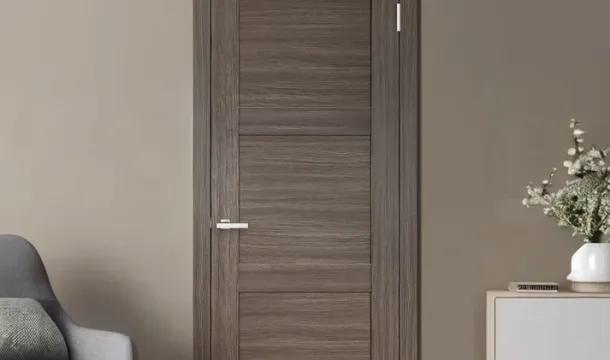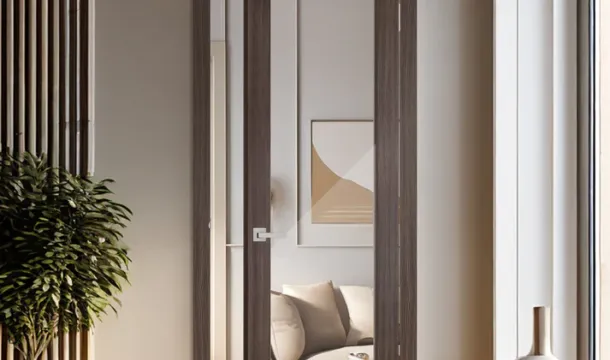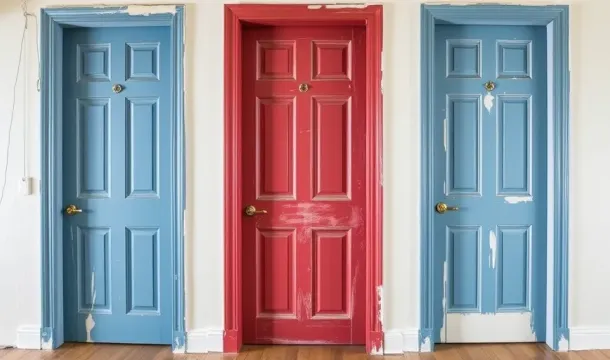Integrating Mirrors for Stylish and Functional Interior Door Design
Popular Articles
- Choosing the Perfect Interior Doors for Your Canadian Home
- A Complete Guide to Choosing Interior Doors for Canadian Homes
- The Challenges of Painting Interior Doors
- Understanding Interior Doors and Their Role in Your Home
- The Perfect Blend of Reliability and Design: Interior Doors with Italian "Sandwich" Technology
Incorporating glass panels within door frames transforms an ordinary threshold into a dynamic decor element that amplifies natural lighting and introduces striking reflections. Selecting clear or frosted glass options can redefine the perception of room size, making compact areas feel open and airy without sacrificing privacy.
Opt for slim, modern profiles in materials like aluminum or matte black to complement contemporary interiors while maintaining structural integrity. The interplay between light and glass creates subtle reflections that animate surrounding walls and floors, enriching the overall ambiance.
Strategically placing these glazed doors near light sources enhances illumination flow across adjacent spaces, reducing reliance on artificial lighting during daylight hours. This approach not only elevates aesthetic appeal but also contributes to energy efficiency by maximizing available natural light.
Choosing Mirror Types for Doors
Select glass with thickness between 4mm and 6mm to ensure durability without adding excessive weight that could compromise door functionality. Opt for tempered or laminated variants to enhance safety, especially in high-traffic areas.
Consider full-length reflective panels when the goal is to visually expand space and boost natural lighting within a room. These create an uninterrupted reflection, amplifying brightness while maintaining a sleek, modern aesthetic.
For rooms requiring subtle style accents, framed mirrors with slim metal or wood borders introduce texture and complement existing decor without overwhelming the visual balance. Matte or brushed finishes on frames add sophistication while reducing glare.
Glass Options Impacting Reflection and Practicality
Clearness of reflection varies by glass type: low-iron glass offers superior clarity, ideal for dressing areas or bedrooms where true color rendering matters. Conversely, tinted or antiqued glass adds atmospheric depth but slightly diffuses light.
Integrating frosted or patterned glass segments breaks monotony and introduces privacy while still enhancing lighting effects through partial reflection. This approach suits multifunctional spaces where both openness and discretion are needed.
Balancing Style with Spatial Functionality
Sliding doors benefit from lighter mirror types to ease movement; consider acrylic-based reflective surfaces as alternatives to traditional glass to reduce weight without sacrificing appearance. However, verify scratch resistance and longevity when choosing plastics.
Hinged doors accommodate heavier options allowing for thicker glass or elaborate frame designs that become focal points rather than mere functional elements. Pair these with complementary hardware finishesbrushed nickel or matte blackto unify the contemporary look.
Ultimately, selecting the appropriate reflective surface enhances the room's atmosphere by optimizing light distribution and expanding perceived dimensions while aligning with stylistic preferences and practical use cases.
Installing Glass Panels Without Damage
Use adhesive strips specifically designed for glass mounting to avoid drilling holes that may weaken the door's structure. Choose high-strength, double-sided tape with foam backing to accommodate slight surface irregularities and ensure a secure bond without harming paint or wood finishes.
When working with framed panels, position rubber bumpers between the frame and door surface to prevent scratches and distribute pressure evenly. This small detail preserves both the decor integrity and the reflection quality over time.
Preventing Cracks and Maintaining Functionality
Avoid heavy hardware attachments; instead, rely on lightweight mounting options that maintain door movement fluidity. If screws are necessary, pre-drill pilot holes slightly smaller than screw diameter to reduce stress on the glass edges. Use washers and rubber grommets to cushion contact points.
Optimizing Space While Preserving Style
Consider frameless glass panels affixed with minimalistic clips or magnetic mounts that allow easy removal for cleaning or repositioning. This approach enhances room brightness through seamless reflections while keeping installation reversible and damage-free. Proper alignment ensures consistent style flow within modern interiors without compromising structural integrity.
Maximizing Space with Mirrored Doors
Utilize full-length reflective glass panels on sliding or bi-fold doors to visually expand confined quarters without sacrificing functionality. The uninterrupted reflection doubles perceived room dimensions, creating a sense of openness especially valuable in compact apartments or narrow hallways.
Incorporate slim frames around the glass to maintain structural integrity while minimizing visual clutter. Choose finishes that complement existing decorbrushed metal or matte black frames add modern flair, whereas wooden trims provide warmth and texture.
Position doors opposite natural light sources like windows or skylights to amplify brightness through strategic reflection. Enhanced lighting not only enlarges space perception but also elevates ambiance, reducing dependence on artificial illumination during daytime.
Optimizing Placement and Style
Install mirrored panels on closet doors facing main living areas to serve dual purposes: storage access and spatial enhancement. This placement leverages reflection to break up solid wall expanses, adding depth and interest without additional furnishings.
Select glass with subtle tinting or anti-glare coatings when needed to balance style with practicality, preventing overwhelming brightness while preserving clarity of reflected images. This adjustment supports comfort and usability in rooms with intense sunlight exposure.
Maintaining Glass Surfaces Properly
Clean reflective surfaces with a microfiber cloth and a solution of water mixed with a few drops of mild dish soap to avoid streaks and damage. Avoid abrasive cleaners or rough materials that can scratch the glass and dull its clarity, diminishing the room's lighting and overall decor appeal.
Regular dusting prevents buildup that reduces reflection quality, preserving the crispness essential for enhancing space perception. Use circular motions when wiping to maintain an even shine across the entire surface, which supports the modern style of your doors while maximizing their functionality.
Protecting Against Moisture and Damage
Keep humidity levels low in spaces prone to moisture exposure since excess dampness can cause frame warping or glass cloudiness. Installing proper ventilation near mirrored elements helps sustain both appearance and durability, ensuring consistent visual impact throughout the room.
Handling Minor Imperfections
Small scratches on glass can be minimized by using specialized polishing kits designed for delicate surfaces. Applying these treatments carefully prolongs the lifespan of your reflective panels without compromising style or spatial effects created by light interaction.
Combining Mirrors with Door Materials
Pairing reflective surfaces with specific door substrates enhances both visual appeal and practical use. Glass panels integrated within wooden frames, for example, amplify natural lighting by bouncing light deeper into the room while preserving warmth and texture.
Consider these material combinations to elevate decor and spatial perception:
- Wood and Mirrored Panels: Use hardwood or engineered wood as a sturdy base, adding mirrored inserts for contrast. The reflection breaks monotony, creating a modern yet cozy ambiance suitable for bedrooms or hallways.
- Aluminum Frames with Glass Elements: Slim aluminum borders paired with large glass sections create sleek, minimalistic doors. This setup emphasizes clean lines and maximizes space perception through unobstructed reflection.
- Laminated Surfaces with Partial Reflective Finishes: Laminates allow diverse textures and colors; selective glossy mirror patches can accentuate style points without overwhelming the overall decor.
The size and placement of glass affect functionalityfull-length reflective panels enlarge room appearance but may require reinforcement to avoid fragility. Frosted or tinted glass options soften reflections, balancing privacy with light diffusion in bathrooms or offices.
Integrating mirrors strategically on sliding doors made from composite materials can visually double available space while maintaining smooth operation. When combining reflective elements with metal hardware finishes like brushed nickel or matte black, the result is a harmonious blend of durability and elegance.
Reflection quality depends heavily on substrate flatness; warped wooden doors should be stabilized prior to applying mirrored components to prevent distortion. Additionally, precise alignment ensures consistent light behavior, enhancing ambient illumination without glare.
Popular Articles
- Choosing the Perfect Interior Doors for Your Canadian Home
- A Complete Guide to Choosing Interior Doors for Canadian Homes
- The Challenges of Painting Interior Doors
- Understanding Interior Doors and Their Role in Your Home
- The Perfect Blend of Reliability and Design: Interior Doors with Italian "Sandwich" Technology

Choosing the Perfect Interior Doors for Your Canadian Home

A Complete Guide to Choosing Interior Doors for Canadian Homes
